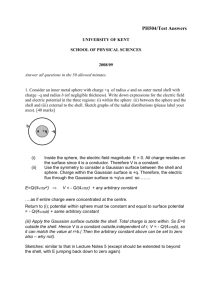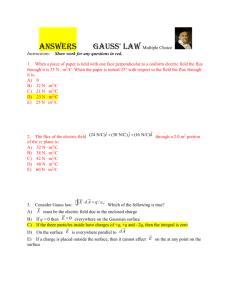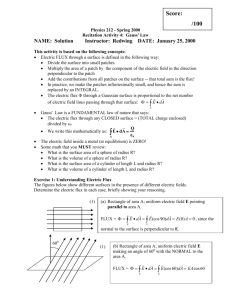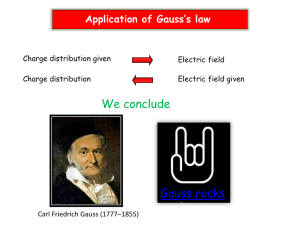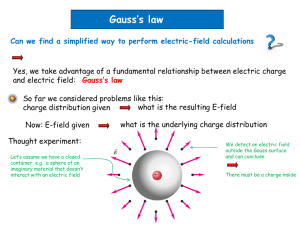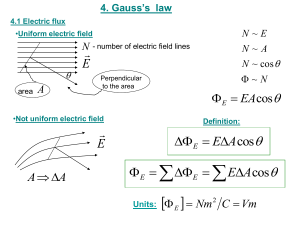Lecture 5 Electric Flux and Flux Density, Gauss Law in Integral Form
advertisement
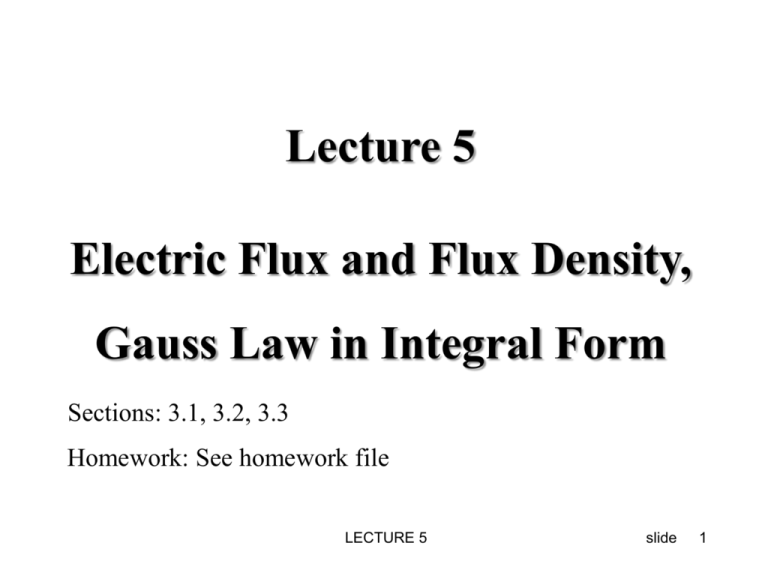
Lecture 5 Electric Flux and Flux Density, Gauss Law in Integral Form Sections: 3.1, 3.2, 3.3 Homework: See homework file LECTURE 5 slide 1 Faraday’s Experiment (1837), Flux • charge ‘transfer’ from inner to outer sphere • electric induction: charge deposition without contact E +Q • observations on charge on outer electrode it is of the same magnitude but opposite sign (−Q) as that on inner electrode it is the same regardless of the insulating material used (εr) it is the same regardless of electrode’s shape b a εr insulator −Q A displacement flux ≡ electric flux Ψ =Q, C flux depends on the charge and does not depend on the medium LECTURE 5 slide 2 Flux Density and Flux – 1 • charge densities on inner and outer spheres Q −Q ou Q>0 = ρ sin = ρ s 2 2 4π a 4π b • flux has direction and density D corresponding to the enclosed charge density (flux density points from +Q to −Q) = Q ∫∫ ρ s ds = ⇔ Ψ ∫∫ Dn ds S S • in spherical coordinates (charged sphere +Q at origin) on the surface of the inner sphere Dn = Dr Ψ Q 2 ⇒ D= in = Ψ D ⋅ 4 π a ( a ) = = ρ r +Q r r s a 2 2 4π a 4π a b Dn on the surface of the outer sphere S Ψ − Q ou = Ψ Dr ⋅ 4π b2 ⇒ D= = = − ρ r ( b) s −Q 4π b2 4π b2 LECTURE 5 slide 3 Flux Density and Flux – 2 • flux density at any distance r (point charge at origin) Q 1 Q ) ( r ) Ψ= Dr ⋅ 4π r 2 ⇒ Dr ( r= ⇒ D = ⋅ 2 ar 2 4π r 4π r • compare with E of a point charge at origin 1 Q (r) E= ⋅ 2 ar 4πε r • E depends on the permittivity, D does not: D describes the sources regardless of the medium Dn = Dr +Q r b S −Q • in vacuum D = ε 0 E • the principle of superposition applies to D as well 1 ρ v (r′)a R dv′ D(r′) = ∫∫∫ 2 4π v′ R LECTURE 5 slide 4 Flux Density D of Fundamental Charge Configurations • multiple point charges 1 N Qn (rn′ ) 1 N Qn (rn′ ) E(r ) = ⋅ ∑ a ⇒ D( r ) = ⋅ ∑ a 2 n 2 n 4πε n 1 = 4π n 1 | r − rn′ | | r − rn′ | • line charge ρl 1 ⋅ ⋅ ( cosθ1 − cosθ 2 ) E ρ= 4πε ρ ρl 1 ⋅ ⋅ ( sin θ 2 − sin θ1 ) E z= 4πε ρ ρl Dρ = ⋅ ( cosθ1 − cosθ 2 ) 4πρ ρl Dz = ⋅ ( sin θ 2 − sin θ1 ) 4πρ P2 θ 2 R2 dQ = ρl dz ′ dz ′ θ α ′ z L z 0 y x θ1 az R ρ aρ P ( ρ , φ ,0) R1 P1 ρs • infinite sheet of uniform charge: = E an ⇒= D ? 2ε 5 Total Flux through Closed Surface • total flux through closed surface depends neither on the surface shape nor on the mutual positioning of the charge and its enclosing surface • it depends solely on the enclosed charge • analogies: water flow, electrical current, etc. find the mathematical expression for flux so that the above is true ? Ψ (D, S ) = procedure: consider a point charge at the origin and its electric flux through: (a) sphere, (b) any surface if the expression is true for a point charge it will be true for any collection of charges as per the superposition principle LECTURE 5 slide 6 Background: Solid Angle and 1 Steradian • 1 radian of a 2D angle (φ = 1 rad) cuts out an arc from a circle of length equal to the radius of the circle if ϕ 1,= larc r larc = r ⋅ ϕ = if ϕ 2= = π , larc 2π r full circle • 1 steradian of a solid angle (Ω = 1 sr) cuts out an area from a sphere equal to (radius)2 ssph= r 2 ⋅ Ω = if Ω 1,= ssph r 2 = if Ω 4π= , ssph 4π r 2 full sphere LECTURE 5 slide 7 Differential Solid Angle and Differential Surface Area • differential solid angle and differential surface area on a sphere ds = r 2d Ω in SCS: ds = r 2 sin θ dθ dφ dΩ example: the area and the solid angle of a full sphere (radius is r0) Asph = ∫∫ 2π π ds = Sphere ∫ 2 2 2 2 π r sin d d r 2 ( cos ) 4 r , m θ θ φ = ⋅ π ⋅ − θ = π 0 0 0 0 ∫ 0 0 2π π Ω = sph d Ω ∫ ∫ sin θ dθ= dφ ∫∫ = Sphere 0 0 4π , sr solid angle of full 3D space LECTURE 5 slide 8 True or False The solid angle defined by 0 ≤ θ ≤ π / 2 and 0 ≤ φ ≤ 2π is equal to 2π. The solid angle defined by a rectangular trihedral corner is equal to π/2. LECTURE 5 slide 9 Total and Differential Flux of Point Charge flux through a sphere (charge at origin) ds 2π π 2 sin= D ds D r Ψ = θ dθ d φ Q n r ∫∫ ∫ ∫ sphere 0 0 dΨ due to spherical symmetry Q Dr ( r ) = 2 4π r 2 d Ψ =Dr r dΩ dS ⇒ dΨ = Q d Ω , d Ω =sin θ dθ dφ 4π r1 r2 Q 4π dΩ dΨ http://phys23p.sl.psu.edu/phys_anim/EM/sphere_to_sphere.avi the differential flux dΨ is proportional to (QdΩ) and does not depend on r LECTURE 5 slide 10 Differential Flux of Point Charge flux through arbitrary surface (charge is at origin) • differential flux through surface element of an arbitrary surface dssphere = dsother cos α an α ar dΩ 0 http://phys23p.sl.psu.edu/phys_anim/EM/patch_to_sphere.avi http://phys23p.sl.psu.edu/phys_anim/EM/fpbts3.avi dssphere dsother • we want d Ψ sphere =Ψ d other =Ψ d Qd Ω d Ψ sphere = Dr dssphere = Dr cos α dsother = Dn dsother = D ⋅ ds dssphere • general expression for differential flux d Ψ= D ⋅ ds LECTURE 5 slide 11 Total Flux of Point Charge Through Arbitrary Surface • regardless of the chosen surface = Ψ ds ∫∫ D ⋅= Q S dΩ • as per superposition principle, result holds for any collection of charges P′ dΩ Q S2 Ssphere P′ Q2 Q1 Q = Q1 + Q2 Ψ = Ψ1 + Ψ 2 S1 P′′ Sother single charge at origin http://phys23p.sl.psu.edu/phys_anim/EM/blob_diced.avi Sother any two charges 12 Gauss’ Law the electric flux over a closed surface is equal to the total charge enclosed by the surface Ψ= ∫∫ D ⋅ ds= ∫∫∫ ρv dv Q= S flux equals enclosed charge (no enclosed charge means no flux) Q v d Ψ ′′ =− d Ψ ′ Qd Ω a n D( P′′) a n dΩ P′′ P′ D( P′) d Ψ′ < 0 total flux Ψ =0 S LECTURE 5 d Ψ ′′ > 0 slide 13 Gauss Law: Applications Gauss’ law makes solutions to problems with planar, cylindrical or spherical symmetry easy procedure: choose integration surface so that D is everywhere either normal or tangential to surface if normal: D ⋅ ds = Dds if tangential: D ⋅ ds = 0 when normal to surface, D is also constant on surface ∫∫ D ⋅ ds = ∫∫ D ⋅ ds = D ⋅ S S S LECTURE 5 slide 14 Gauss Law Applications: Field of Infinite Line Charge z ∫∫ D ⋅ ds = Q = ρl ⋅ l S due to symmetry D = Dρ a ρ 2π ⇒ l ∫ ∫ x φ ρ Dρ ρ dφ dz =Dρ ⋅ 2πρ l =ρl l y = φ 0=z 0 l ρl ⇒D= aρ , C/m 2 2πρ ρl D , V/m ⇒E= = aρ ε 2περ ds = ρ dφ dza ρ S ρl This result was already obtained in Lecture 4 by the superposition principle. LECTURE 5 slide 15 Gauss Law Applications: Field of Coaxial Cable problem has cylindrical symmetry Gaussian surface chosen as cylinder of radius ρ solution analogous to that of line charge • for a ≤ ρ ≤ b ρl D = aρ , C/m 2 2πρ • for ρ > b, D = 0 ρ Homework: Prove that for a uniformly charged cylinder ρv = of radius a, Dρ ρ , for 0 ≤ ρ ≤ a. 2 LECTURE 5 slide 16 Gauss’ Law Applications: Field of Sheet Charge ∫∫ D ⋅ ds = Q = ρ s ⋅ A D top lx an ly S z y ρs x δ A = lxl y S D bottom an ∫∫ Dz dxdy − ∫∫ Dz dxdy + ∫∫ D ⋅ ds = ρs A top sides bottom bottom Dztop ⋅ A due to Dz ⋅A symmetry: Dztop ρs flux through S is 0 = − Dzbottom ρs = D ⇒ 2 DA = ρ s A, D = 2 ρs D ⇒D= ± az ⇒ E = = ± az 2 2ε ε This result was already obtained in Lecture 4 by the superposition principle. LECTURE 5 slide 17 Gauss’ Law Applications: Field of Spherical Charge A sphere of radius a has uniformly distributed charge of volume density ρv, C/m3. Determine the electric flux density in the sphere and out of it. • spherical symmetry of the source implies spherical symmetry of field • choose integration surface as sphere (1) inside the sphere ∫∫ D ⋅ ds= Q ( r )= S (r) ∫∫∫ ρ v dv= ρ v ∫∫∫ dv v(r) v(r) 4 3 Dr ( r ) ⋅ 4π r = ρv π r 3 2 ρv ⇒ Dr (r ) = r 3 v(r) LECTURE 5 slide 18 Gauss’ Law Applications: Field of Spherical Charge (2) outside the sphere 4 3 ∫∫ D ⋅ ds = Q = ∫∫∫ ρ v dv = ρ v ⋅ 3 π a S (r) v 4 3 Dr ( r ) ⋅ 4π r == Q ρv π a 3 ρv a3 Q ⇒ Dr ( r ) = 2 = ⋅ 2 3 r 4π r 2 ρv a Dr 3 1/ R 2 0 a R • outside the sphere the field is the same as that of a point charge LECTURE 5 slide 19 Gauss’ Law Applications: Field of Spherical Charge E-field magnitude in 3-D space LECTURE 5 slide 20 You have learned about: the flux density vector D and how it relates to the charge Q and the E vector Gauss’ law of electrostatics in integral form Ψ= ∫∫ D ⋅ ds= S Q= ∫∫∫ ρv dv v the application of Gauss’ law to the solution of symmetrical problems • infinite planar charge • infinite line charge • infinite cylinder (inside and outside) • coaxial cable • uniformly charged sphere (inside and outside) LECTURE 5 slide 21



